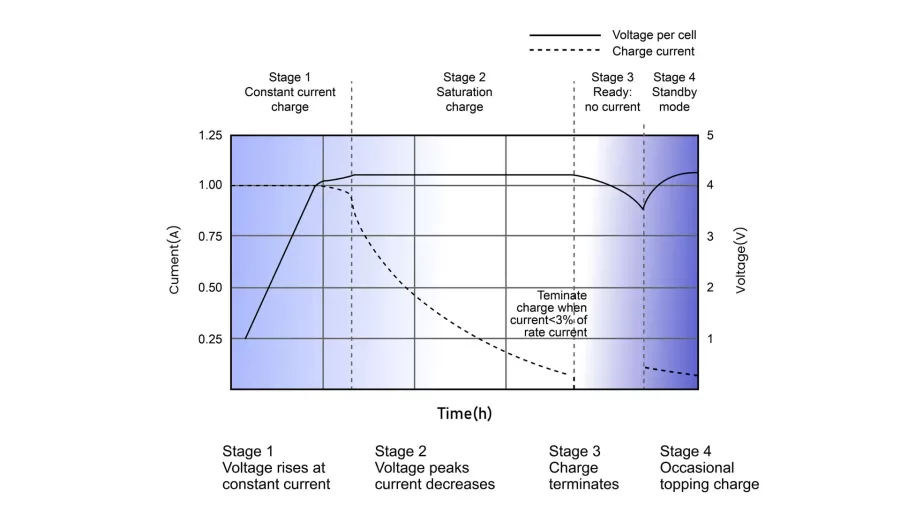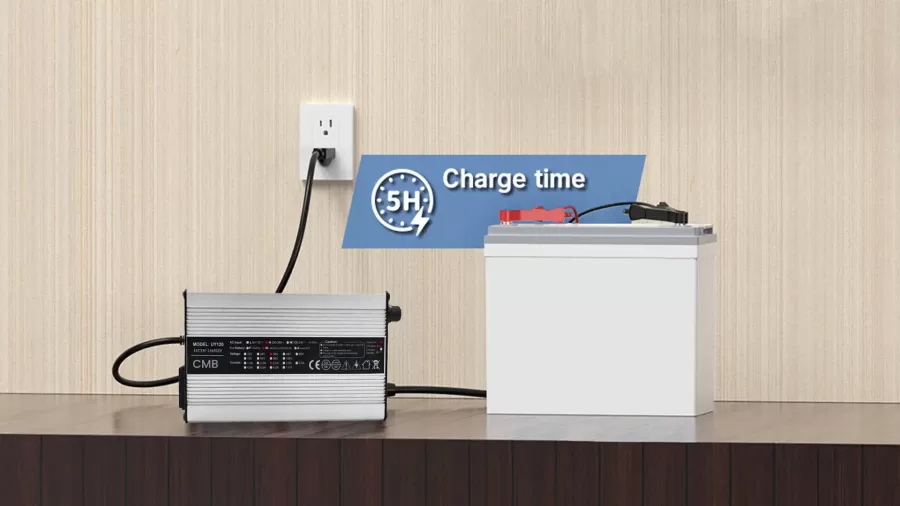Some battery users are confused about how to choose a Li-ion battery charger. It is vital to understand how 18650 battery chargers work. Choosing the right charger is critical for optimal battery performance and safety. We will delve into the technical aspects of the charging phase, explore function-based charger classifications, and emphasize the importance of choosing a compatible and safe charger.
Lithium-Ion 18650 Battery Charger: A Deep Dive into CC, CV, and Float
The three main stages of charging a lithium-ion battery are constant current (CC), constant voltage (CV), and float charging. Each stage involves specific circuits and components to ensure an efficient and safe charging process.

Constant Current (CC) Stage
During the CC stage, the lithium-ion battery is charged at a constant current. This stage is designed to quickly charge the battery until it reaches a certain voltage threshold. The charging current is typically set to a safe maximum value determined by the battery’s specifications.
Circuits and Components Involved:
- Charger Controller: The charger controller regulates the charging current and monitors the battery voltage. It ensures that the charging current remains constant until it reaches the specified voltage threshold.
- Current Sensing Circuit: This circuit measures the charging current and provides feedback to the charger controller, enabling it to adjust the charging rate accordingly.
Constant Voltage (CV) Stage
Once the battery voltage reaches the specified threshold in the CC stage, the 18650 Battery charging process transitions to the CV stage. In this stage, the charging voltage is held constant while the current gradually decreases. The CV stage ensures that the battery is charged to its full capacity without overcharging.
Circuits and Components Involved:
- Charger Controller: The charger controller switches the charging mode from CC to CV when the battery voltage reaches the threshold. It regulates the charging voltage and monitors the battery’s current to prevent overcharging.
- Voltage Sensing Circuit: This circuit measures the battery voltage and provides feedback to the charger controller, allowing it to maintain the desired voltage level.
Float Charging Stage
After the CV stage, some charging systems may enter the float charging stage to maintain the battery’s charge at a lower voltage level. Float charging is typically used in applications where the battery is continuously connected to a charger, such as backup power systems. It helps prevent self-discharge and keeps the battery ready for immediate use.
Circuits and Components Involved:
- Charger Controller: In float charging, the charger controller continuously monitors the battery voltage and adjusts the charging voltage to a lower level, maintaining it at a specific value. This allows the battery to remain charged without overcharging.
Pulse Charging and Balancing
Pulse charging is a technique that involves periodically interrupting the charging current to minimize lithium plating and improve charging efficiency. These interruptions in the charging process help prevent the formation of dendrites, which can cause a short circuit and reduce battery performance.
Battery balancing is another critical aspect of charging lithium-ion batteries. Balancing ensures that each cell within a battery pack is charged and discharged evenly, preventing imbalances that could affect the overall performance and lifespan of the battery. Balancing circuits monitor cell voltages and redistribute the charging current among the cells to maintain balance during the charging process.
Overall, these stages, circuits, and techniques work together to provide safe and efficient charging for lithium-ion batteries, promoting optimal performance and prolonging the battery’s lifespan.

Understanding 18650 Battery Charger Categories by Function
Many people ask “How to charge an 18650 battery?”, but the premise is that we must understand the 18650 battery charger category by function.
1. Basic Chargers
- These chargers provide a simple way to charge 18650 battery packs.
- They usually have a fixed output current and voltage range, typically around 1A and 4.2V respectively.
- Basic chargers may lack safety features like overcharge protection or short circuit prevention.
2. Smart Chargers
- These chargers offer more advanced features and functionality compared to basic chargers.
- They have adjustable output current and voltage settings, allowing for more precise charging.
- Smart chargers often include safety features like overcharge protection, short circuit prevention, and reverse polarity protection.
- Some models may also have LCD displays to show charging progress or battery information.
3. Fast Chargers
- Fast chargers are designed to charge 18650 battery packs at a higher rate compared to standard chargers.
- They typically have a higher output current, such as 2A or more, allowing for faster charging times.
- Fast chargers may incorporate advanced charging algorithms to optimize the charging process and prevent damage to the battery
4. Multi-Bay Chargers
- Multi-bay chargers are capable of charging multiple 18650 battery packs simultaneously.
- They come in various configurations, such as dual-bay, quad-bay, or even more.
- Multi-bay chargers often have individual charging channels, allowing you to charge different batteries at different rates.
5. USB Chargers
- USB chargers are designed for convenience and portability, allowing you to charge your 18650 battery packs on the go.
- They typically feature a USB input, enabling you to charge the batteries from various power sources like laptops, power banks, or car chargers.
- USB chargers may have limited output current and voltage compared to other types of chargers.
6. Specialty Chargers
- Specialty chargers refer to chargers tailored for specific applications or battery chemistries.
- For example, there are chargers specifically designed for LiFePO4 (lithium iron phosphate) chemistry or for charging batteries in solar or off-grid systems.
- Remember to consider factors such as compatibility, power output, safety certifications, and any additional features when selecting a charger that best fits your needs.
Consider factors such as compatibility, power output, safety certifications, and any additional features when choosing the best charger for you.
Importance of Selecting a Safe and Compatible Li-ion 18650 Battery Charger
Using a compatible and safe charger is paramount to avoid overcharging, overheating, or damaging your battery. We’ll emphasize the significance of selecting a charger that meets safety standards and discuss important safety features to look for, including overcharge protection, short circuit protection, and temperature control. By utilizing these safety features, you can charge your 18650 battery with peace of mind, knowing that they are protected from potential hazards. Check out this article for details.
Remember, it is crucial to prioritize safety and ensure your charger is designed for the specific battery chemistry you are using. Using inappropriate chargers can lead to serious consequences and compromise the longevity of your batteries.
Conclusion
Comprehending the working principle of 18650 battery chargers, exploring the various charger types based on functionality, and prioritizing safety are vital aspects of battery usage. By understanding the three main charging stages and their associated circuits and components, users can optimize the performance and lifespan of their batteries. Selecting a charger that meets their specific requirements, while considering safety features and compatibility, is essential for a hassle-free and secure charging experience.
Remember, investing in a high-quality charger that safeguards your batteries not only ensures their longevity but also provides you with reliable and efficient power whenever you need it. For professional guidance, contact us now.

One thought
If the battery capacity is small, maintain the state of charge at around 50%; for larger capacities, keep it between 35% and 50%. The reason for recommending around 50% for small capacity batteries is because they might lose charge during storage; larger capacity batteries are less affected by discharge, hence the 35% to 50% recommendation. During storage, the BMS also consumes power.
During winter, keeping the battery at around 65-70% charge at 30 ℉ is acceptable and can be lowered further.
Keeping the batteries fully charged for extended periods during summer can significantly damage them. It’s recommended to discharge the batteries after charging, using them until at least 30% charge remains before recharging. Continuous maintenance of a fully charged state significantly reduces battery lifespan, especially at high temperatures. Based on your usage pattern, the batteries may degrade by approximately 30% within a year, which is highly undesirable.
Our final recommendation is to control the temperature (above -20°F in winter, below 35°C in summer) and reduce the state of charge to 35% to 50%.